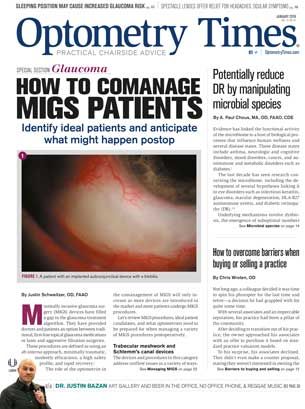How to improve glaucoma referrals

The care that ODs provide and convey to their referral sources can improve the overall quality of glaucoma care.
Glaucoma is a public health concern, according to Michael J. Cymbor, OD, FAAO, of Port Matilda, PA, at American Academy of Optometry’s annual meeting in San Antonio.
“It is the second-leading cause of blindness in the world-the number of patients with glaucoma will double by the year 2040,” he says.1
ODs’ role in influencing and treating glaucoma can have the potential for lasting management in glaucoma patients.
What referral patients want to know
Referencing a 2013 study2 that surveyed a glaucoma subspecialist, Dr. Cymbor shared five top pieces of information participating patients reported wanted to receive from their referral doctors:
• Serial visual fields
• Current interocular pressure (IOP)
• Current therapy
• Peak IOP
• Serial disc imaging
Referral sources in the study included both optometrists and ophthalmologists, as well as general practitioners, Dr. Cymbor says. Some 34 percent of participants in the study missed at least one, if not more, of the five criteria patients wanted.
Related: 9 things glaucoma patients want to know
“If you really want to blow away your glaucoma referral source, calculate mean IOP. Sometimes it is not easy to do, but we know that mean IOP was one of the factors that was used in many studies,” says Dr. Cymbor.
When referral numbers come into the office, the peak IOP is important to consider. Knowing the highest pressure a patient ever hit can help with determining a treatment, according to Dr. Cymbor.
Improving referrals collectively
Dr. Cymbor advises ODs to not blindly trust their optical coherence tomography (OCT). “If you’re so focused on certain things in the OCT, there may be parts that you’re missing,” he says.
With so much information within OCTs, weaning out the right information can help elevate an OD’s level of care.
High myopia, for instance, is one area in which ODs may not want to trust a nerve fiber layer (NFL) scan with an OCT, Dr. Cymbor says. With such high amounts, it can torque the NFL, moving it in a different direction.
“Red disease,” as Dr. Cymbor calls it, is an example of this. It involves diagnosing something that really isn’t there.
Related: Involve patients in monitoring IOP
The average NFL thickness of the superior and inferior retinal nerve fiber layer (RNFL) are looked at as being two of the best predictors of glaucoma progress, visual field narrowing, or otherwise.
Staging glaucoma
At what point do cases go from moderate to severe? Dr. Cymbor recommends using a staging method called the HAP criteria-Hodapp, Anderson, Parrish.
With this, ODs can determine the progression of a patient’s diagnosis: early, moderate or severe. But the caveat is any central points on a visual field study within the four central areas will kick the stage up to the next category, Dr. Cymbor says.
While not the only method of staging, Dr. Cymbor says completing the HAP criteria can be done very quickly in a clinic.
He also raised the question of staging according to OCT.
“There is no accepted criteria now for OCT technology that we can use to grade,” Dr. Cymbor says.
Give a concise procedure history
Dr. Cymbor says it’s surprising how many times a patient will come in, and an OD doesn’t know what previous surgeries the patient had.
“This information is so important to know as you send a patient on,” he says.
Lack of knowledge can cause complications when the patient is referred to a new doctor.
Discuss treatment options beforehand
If an OD sees a patient with mild glaucoma who is not compliant with drops, a discussion should be undertaken with the patient prior to referral, Dr. Cymbor says. Treatment options beyond drops include minimally invasive glaucoma surgeries (MIGS), trabs/tubes, or selective laser trabeculoplasty (SLT).
In Dr. Cymbor’s experience, SLT is one of the most under-utilized procedures within glaucoma care and has low-risk complications.
“If I had glaucoma now, I would choose to have SLT,” he says.
Related: OCT helps diagnose retinoschisis in glaucoma patients
A study conducted on glaucoma patients receiving SLT surgery showed that 70 percent of participants did not require further surgical procedure within a five-year period.3
With MIGS treatment, Dr. Cymbor says the procedure can lower pressure 10 to 15 percent in conjunction with cataract surgery.
Include angle assessment
A number of cases Dr. Cymbor sees in his practice are labeled primary open-angle glaucoma, he says. However, careful angle assessment does not always show that.
“It shows that the angles are often narrow,” Dr. Cymbor says.
Compression gonioscopy, in lieu of a standard gonioscopy, is recommended when conducting open angle-assessments. The smaller footprint lens and a little pressure can ensure an angle opens up, Dr. Cymbor says.
Evaluate risk factors
For a patient with siblings, the risk for those brothers and sisters developing the disease increases by two-fold, Dr. Cymbor says.
If they haven’t already, Dr. Cymbor recommends siblings of glaucoma patients to have their eyes checked immediately and mention a sibling has the disease.
Other potential threats include:
• Smoking
• Low blood pressure
• Sleep apnea
• Pesticides
• Hypertension medication
• Obesity
• Diabetes
• Migraines
Aggressively manage secondary glaucoma
Often ODs are trained to think of glaucoma as progressing slowly over time. While this is true in some cases, it can also move more forcefully as Dr. Cymbor says.
Patients with exfoliation or pigmentary glaucoma should be scheduled for office visits every six months, even if they appear stable during a five-year period of checkups.
Related: Diet change may affect glaucoma risk
“Do not wait a year to see these patients again,” Dr. Cymbor says. “Because you never know-particularly with pseudoexfoliation-when they are going to turn bad.”
Value of corneal hysteresis
The Ocular Response Analyzer (ORA, Reichert) tests IOP and is considered to be the most accurate method for obtaining IOP. 4
The drawback of the ORA, Dr. Cymbor says, is cost: Prices can range from $15,000 to $16,000.
Despite the steep price tag, the ORA is viewed as the most accurate test for corneal hysteresis, a process in which the cornea absorbs and dissipates energy.3
Studies show that corneal hysteresis is the strongest parameter for visual field progression,5 Dr. Cymbor says.
“It’s a hugely important factor as it relates to managing both early and advanced glaucoma,” he says.
References:
1. World Health Organization. Bulletin of the World Health Organization: Volume 82, Number 11, November 2004, 811-890. Available at https://www.who.int/bulletin/volumes/82/11/en/. Accessed 12/11/18.
2. Rizwan M, Baker H, Russel RA, Crabb DP. A survey of attitudes of glaucoma subspecialists in England and Wales to test visual field test intervals in relation to NICE guidelines. BMJ Open. 2013 May 3; 3(5): e002067.
3.Ehrlich JR, Radcliffe NM, Shimmyo M. Goldmannn applanation tonometry compared with corneal-compensated intraocular pressure in the evaluation of open-angle glaucoma. BMC Ophthalmol. 2012 Sep 25;12:52.
4. Hussnain SA. The role of cornea in glaucoma management: central corneal thickness and corneal hysteresis. Available at: http://eyewiki.aao.org/The_Role_of_Cornea_in_Glaucoma_Management%3A_Central_Corneal_Thickness_and_Corneal_Hysteresis. American Academy of Ophthalmology. Accessed 12/10/18.
5. De Moraes CV, Hill V, Tello C, Liebmann JM, Ritch R. Lower corneal hysteresis is associated with more rapid glaucomatous visual field progression. J Glaucoma. 2012 Apr-May;21(4):209-13.

Newsletter
Want more insights like this? Subscribe to Optometry Times and get clinical pearls and practice tips delivered straight to your inbox.